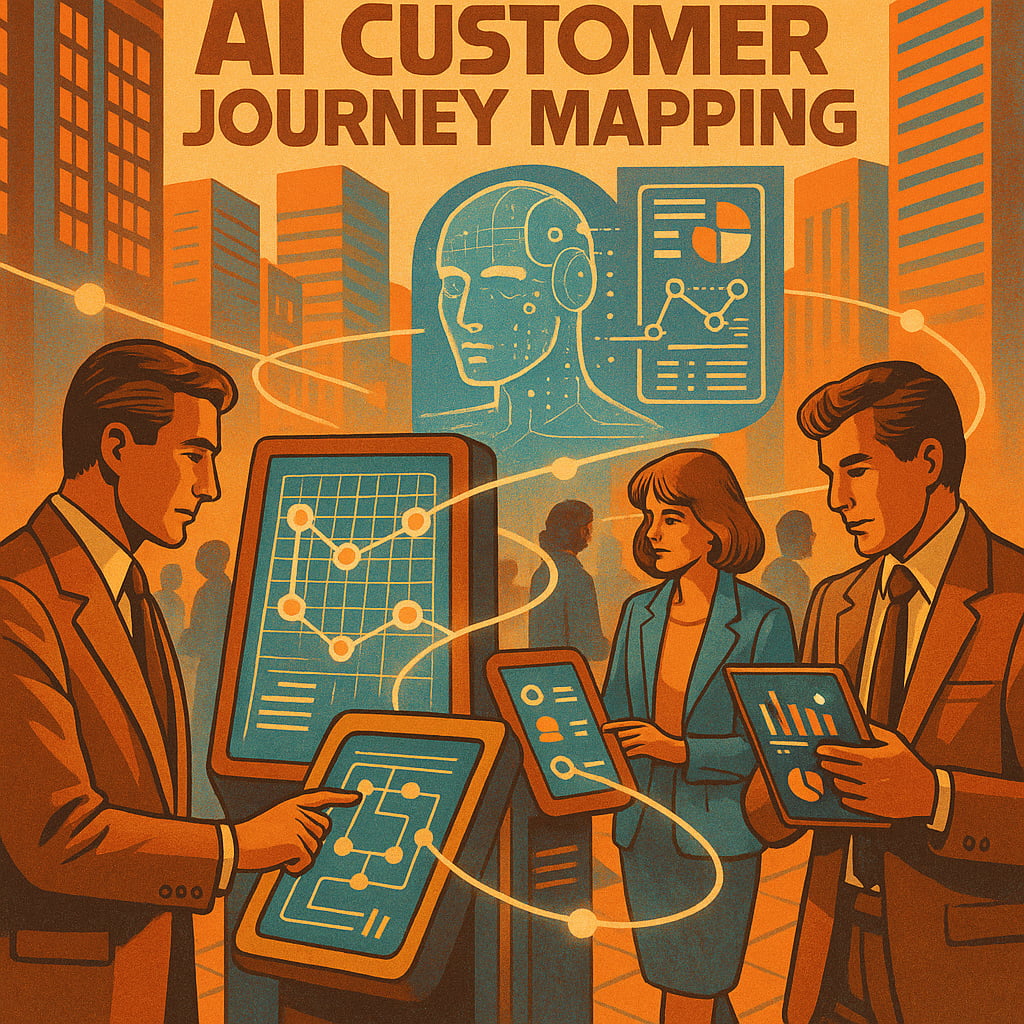Ai Customer Journey Mapping



AI Customer Journey Mapping Isn't Just Faster, It's Smarter
Customer journey mapping has always been a messy, time-consuming process. Teams spend weeks pulling together scattered feedback from support tickets, surveys, and random customer conversations. They struggle to identify meaningful patterns buried in spreadsheets and sticky notes, often resorting to educated guesswork about what customers actually experience.
The traditional approach means wasting countless hours trying to piece together a coherent picture from fragmented data sources. Teams frequently miss critical pain points because they're buried in noise, and by the time a journey map is complete, customer behaviors may have already shifted.
This guide will show you how AI can dramatically reduce the effort required while improving the accuracy of your journey maps. The best part? You don't have to sacrifice the human insight and strategic thinking that makes journey mapping valuable in the first place.
What AI Can Actually Do in Journey Mapping
AI brings several powerful capabilities to customer journey mapping that can transform how teams understand their customers:
Analyzing data for patterns in customer pain points and touchpoints - AI can process thousands of customer interactions simultaneously, identifying recurring issues and friction points that would take humans weeks to spot manually. It can detect subtle patterns across different channels and touchpoints that reveal the true customer experience.
Predicting future customer behaviors - By analyzing historical data and current trends, AI can forecast how customers are likely to behave at different journey stages. This helps teams proactively address potential issues before they become widespread problems.
Segmenting customers based on emotion, need, or behavior - AI can automatically group customers into meaningful segments based on their emotional states, underlying needs, or behavioral patterns. This creates more nuanced journey maps that reflect the diversity of your customer base rather than generic, one-size-fits-all experiences.
Identifying hidden connections between touchpoints - AI excels at uncovering relationships between seemingly unrelated customer interactions, revealing how experiences in one area affect satisfaction in another.
Processing unstructured feedback at scale - AI can analyze open-ended survey responses, social media mentions, and support conversations to extract actionable insights that would be impossible to process manually.
While AI tools can work much faster than traditional methods, they're only as effective as the inputs you provide. They still rely heavily on access to real customer data and a clear customer experience strategy to guide their analysis. Without quality data and strategic direction, even the most sophisticated AI will produce generic or misleading insights. See how Blaze helps you get started with online marketing
From Raw Data to Action: Unlocking Deeper Insights with AI
Successful customer journey mapping relies on more than just speed — it demands clarity, accuracy, and real-world relevance. By combining qualitative and quantitative data, teams can gain a 360° view of the user journey and extract valuable insights that drive real change.
AI tools don’t just process data — they uncover insights from customer feedback, behavior patterns, and data points across multiple channels. With advanced machine learning algorithms and predictive analytics, teams can anticipate customer needs, understand customer emotions, and fine-tune messaging at each stage of the buyer's journey.
This level of analysis enables smarter marketing strategies. For example, by identifying gaps through data collection and web analytics, companies can adjust their marketing campaigns to better reflect what customers actually want — not what internal teams assume.
In practice, AI empowers organizations to:
- Gain insights into what drives or blocks customer loyalty
- Align product decisions with real-world customer insights
- Identify opportunities for improvement across touchpoints
- Accurately reflect the customer experience in real time
- Enhance strategic planning for long-term business growth
Explore how Blaze helps you engage with customers at every stage
When done right, AI doesn’t just speed things up — it enables businesses to act with confidence. It helps teams build customer loyalty, capture consumer attention, and make faster decisions with deeper insights — all while saving time and cutting through guesswork.
By leveraging AI, even a complex journey mapping process can be distilled into a visually appealing, actionable model in just a few minutes. The key is ensuring the foundation — clean, relevant data — is strong, and that human teams are ready to interpret and apply AI outputs thoughtfully.
How to Build AI Customer Journey Maps
Building effective AI-powered journey maps requires a systematic approach that combines automation with human judgment. Here's a step-by-step process to get started:
Start small and focus on a single journey stage - Don't try to map the entire customer lifecycle at once. Pick one critical stage where you have the most data and pain points. This could be onboarding, purchase decision, or post-purchase support. Starting narrow allows you to refine your approach before scaling up.
Feed in your most complete datasets - Gather all available customer data for your chosen journey stage. This includes support tickets, survey responses, behavioral analytics, sales conversations, and any other customer touchpoints. Tools like Blaze can help you quickly process and analyze these diverse data sources to identify patterns and insights.
Set clear parameters for the AI analysis - Define what you want to learn before running the analysis. Are you looking for pain points, emotional states, or decision-making factors? Clear objectives help the AI focus on relevant patterns rather than generating generic outputs.
Use AI to identify patterns and generate initial maps - Let the AI process your data to identify common customer paths, pain points, and emotional triggers. Blaze can quickly generate comprehensive journey maps by analyzing your customer data and identifying the most significant touchpoints and experiences.
Validate AI outputs with customer-facing teams - Before acting on any AI-generated insights, review them with your sales, support, and customer success teams. These team members interact with customers daily and can confirm whether the AI's conclusions match their real-world observations.
Iterate and refine based on feedback - Use team input to adjust the journey map, then test the updated version against new customer data. This iterative approach ensures your maps remain accurate and actionable.
Common Mistakes That Ruin the Process
AI isn't a magic shortcut that automatically solves journey mapping challenges. Teams that treat it as such often end up with worse results than manual methods.
Feeding messy data into AI tools will inevitably produce inaccurate journey maps. If your customer data is incomplete, outdated, or inconsistent, the AI will amplify those problems rather than solve them. Garbage in, garbage out applies just as much to AI journey mapping as any other analysis.
Trusting AI output without human validation is another critical mistake. AI can identify patterns, but it can't understand context the way humans can. A customer-facing team member might recognize that a supposed "pain point" is actually a necessary security measure that customers ultimately appreciate, even if they initially resist it.
Creating maps that never lead to action defeats the entire purpose of the exercise. Some teams become so focused on perfecting their journey maps that they never actually use them to improve the customer experience. Remember that mapping is only valuable if it results in real changes to your product, messaging, or customer support experience.
Over-relying on AI for emotional interpretation is particularly problematic. While AI can identify patterns in customer language and behavior, it often misses the nuanced emotional context that drives customer decisions. Human insight remains essential for understanding the "why" behind customer actions.
How to Make Sure Your Journey Maps Actually Lead to Action
The most sophisticated journey map is worthless if it sits in a presentation deck and never influences real business decisions. To ensure your AI-generated insights drive meaningful improvements, focus on translating discoveries into specific, actionable changes.
Changing website copy based on journey map insights can dramatically improve conversion rates. If your analysis reveals that customers feel confused about pricing at a specific stage, update your messaging to address those concerns directly. Clear, customer-focused copy that addresses real pain points will resonate much better than generic marketing language.
Adjusting email funnel sequences helps align your communications with actual customer needs and timelines. Your journey map might reveal that customers need more time to evaluate features before receiving purchase-focused emails, or that they're looking for social proof at a different stage than you assumed.
Fixing confusing user flows directly addresses friction points identified in your analysis. If customers consistently struggle with a particular process or interface element, your journey map provides the evidence needed to prioritize those improvements in your product roadmap.
Updating FAQs and help documentation ensures your support resources match the questions customers actually ask at each journey stage. AI analysis can reveal gaps between what you think customers need to know and what they're actually trying to figure out.
The key is treating your journey map as a starting point for improvement rather than an end goal. Teams that actively use their insights to make specific changes will see measurable improvements in customer satisfaction, while those that simply create maps for the sake of having them will waste their effort.
When to Avoid Using AI for Journey Mapping
AI isn't always the right tool for journey mapping, and recognizing when to use alternative approaches will save you time and produce better results.
Businesses with very little customer data should avoid AI-powered journey mapping entirely. If you have fewer than a few hundred customer interactions to analyze, AI tools will likely produce weak or misleading insights based on insufficient information. The patterns AI identifies won't be statistically meaningful, and you'll be better served by direct customer research.
Startups or teams with only a handful of customers are much better off conducting detailed interviews and gathering direct feedback. At this stage, you can personally speak with most or all of your customers, giving you richer insights than any AI analysis could provide. Focus on qualitative research until you have enough customers and data to make AI analysis worthwhile.
Simple customer journeys don't require AI assistance - if your customer journey involves just a few straightforward steps with clear success metrics, traditional mapping methods will be faster and more cost-effective. AI adds the most value when dealing with complex, multi-touchpoint journeys where patterns are difficult to identify manually.
Highly emotional journeys often require human interpretation that AI tools aren't suited for. Industries like medical care, legal support, or financial crisis management involve sensitive emotional contexts that AI may misinterpret. In these cases, human empathy and contextual understanding are essential for creating accurate, helpful journey maps.
Limited internal resources for implementation can also make AI journey mapping counterproductive. If your team lacks the capacity to act on AI-generated insights, you'll be better off starting with simpler, more actionable research methods.
Final Thoughts
AI can significantly improve the speed and accuracy of customer journey mapping, but the most effective approaches combine clean data, smart automation, and human insight. The goal isn't to replace human judgment with AI, but to augment human understanding with data-driven insights that would be impossible to gather manually.
The best journey maps emerge when teams use AI to reveal what's actually happening in their customer experience rather than simply confirming what they already believe. This means being open to surprising discoveries and willing to challenge assumptions about how customers interact with your business.
Remember that technology is just a tool - the real value comes from using these insights to create meaningful improvements in your customer experience. Teams that focus on action over analysis will see the greatest returns from their AI-powered journey mapping efforts.


.svg)